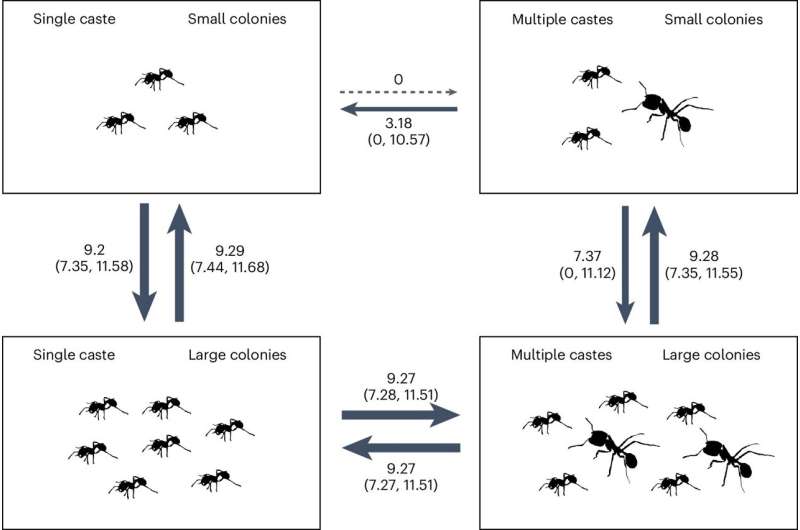This article has been reviewed according to Science X's editorial process and policies. Editors have highlighted the following attributes while ensuring the content's credibility:
fact-checked
peer-reviewed publication
trusted source
proofread
Larger ant colonies drive the evolution of worker castes: Division of labor is key to life's complexity, says study

Just like human societies, ant societies have a division of labor. Within a colony, some individuals feed the young while others are soldiers who protect the colony from intruders. New research across 794 ant species, published in Nature Ecology & Evolution, reveals that group size determines whether or not division of labor evolves.
Remarkably, in some ant species, individuals have become morphologically specialized to carry out their different tasks, despite being siblings. Darwin called the existence of such workers castes his "special difficulty" because it was hard to explain how they evolved.
"We know that larger ant colonies have more worker castes," says Postdoctoral Researcher Philip Downing from the University of Oulu, one of the international study's authors. "The difficulty is working out how this association came to be.
"Which came first? Did large colonies evolve first, followed by castes, or did castes evolve first, which allowed colonies to get larger? To solve this problem, we had to compare modern-day ants with their ancestors."
Since the ant ancestors no longer exist, researchers used statistical approaches to infer what their colony sizes and caste numbers would have been, based on their living descendants. "We found that larger colony sizes evolved before worker castes did, supporting what's known as the size-complexity hypothesis," explains Downing who was involved in coding the statistical analyses.
Lead author Louis Bell-Roberts from the University of Oxford says, "The size–complexity hypothesis is a leading explanation for the evolution of complex life on earth. In line with this, our research shows that larger colony sizes favored the evolution of increased division of labor, resulting in more worker castes and greater variation in worker size."
The results may also offer insights about the evolution of multicellular organisms such as animals and plants.
"Now that we know larger colony size favors more worker castes, the next step is to study what favors larger colony sizes in ants.
"Colony size in ants varies from seven to 14.8 million. Can ecological factors, such as the number of predators, the climate, or even the number of parasites of an ant species explain this?" Downing asks. He plans to conduct large-scale statistical comparisons across many ant species to find out.
More information: Louis Bell-Roberts et al, Larger colony sizes favoured the evolution of more worker castes in ants, Nature Ecology & Evolution (2024). DOI: 10.1038/s41559-024-02512-7
Journal information: Nature Ecology & Evolution
Provided by University of Oulu





















